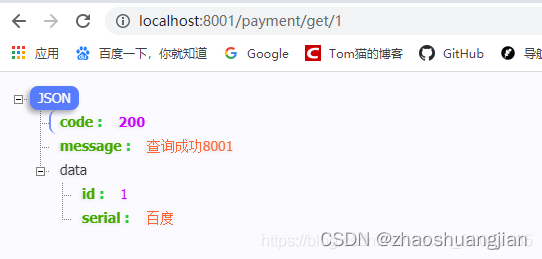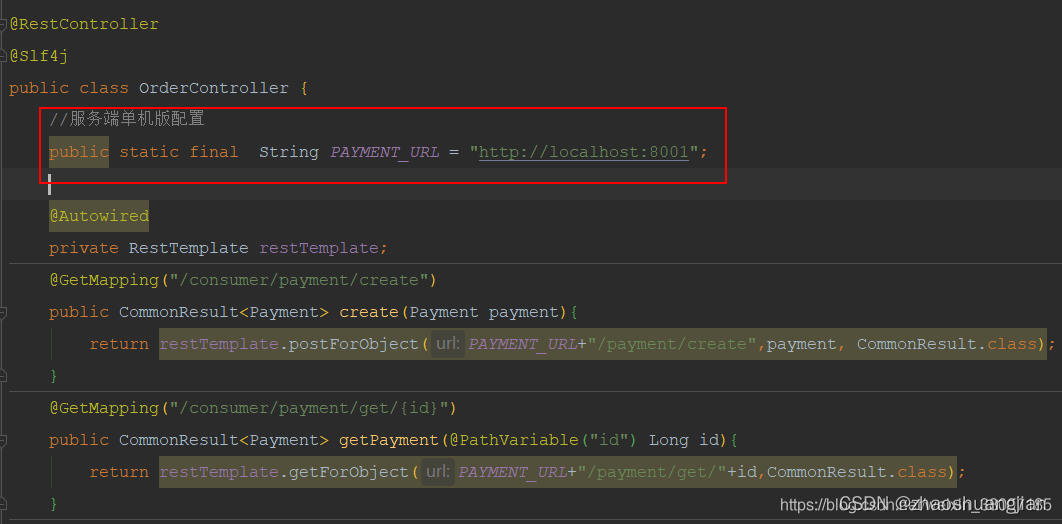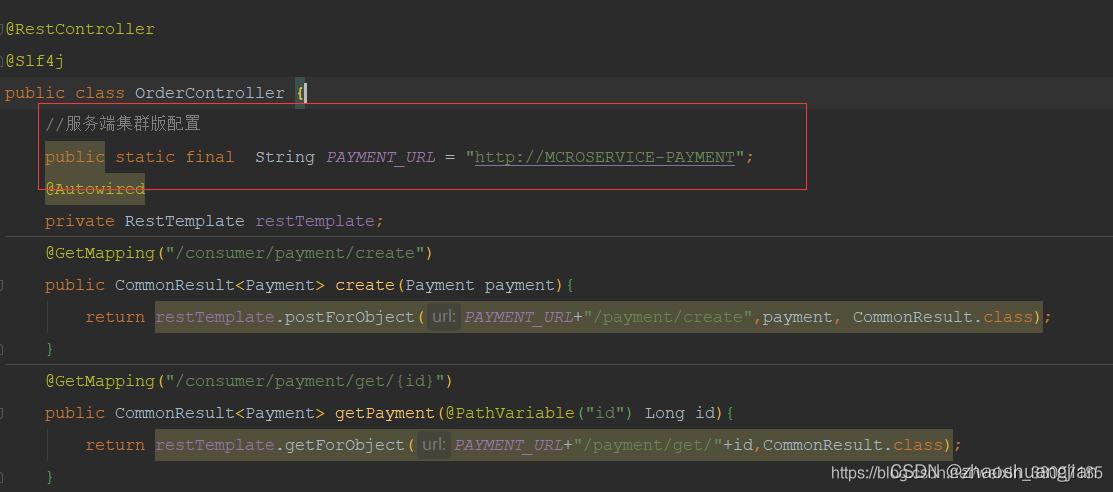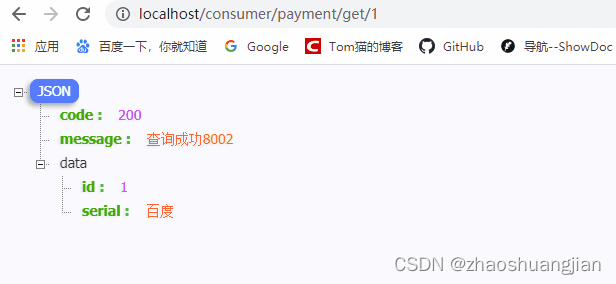一、手把手教你搭建SpringCloud项目(一)图文详解,傻瓜式操作
二、手把手教你搭建SpringCloud项目(二)生产者与消费者
三、手把手教你搭建SpringCloud项目(三)集成Eureka服务注册中心
四、手把手教你搭建SpringCloud项目(四)Eureka集群版搭建
五、手把手教你搭建SpringCloud项目(五)生产者集群版搭建
六、手把手教你搭建SpringCloud项目(六)Eureka实现服务发现
七、手把手教你搭建SpringCloud项目(七)集成Consul服务注册中心
八、手把手教你搭建SpringCloud项目(八)集成Ribbon负载均衡器
九、手把手教你搭建SpringCloud项目(九)集成OpenFeign服务接口调用
十、手把手教你搭建SpringCloud项目(十)集成Hystrix之服务降级
十一、手把手教你搭建SpringCloud项目(十一)集成Hystrix之服务熔断
十二、手把手教你搭建SpringCloud项目(十二 )集成Hystrix之图形化Dashboard实时监控
十三、手把手教你搭建SpringCloud项目(十三 )集成Gateway新一代网关
十四、手把手教你搭建SpringCloud项目(十四 )集成Config分布式配置中心
十五、手把手教你搭建SpringCloud项目(十五)集成Bus消息总线
十六、手把手教你搭建SpringCloud项目(十六)集成Stream消息驱动
十七、手把手教你搭建SpringCloud项目(十七)集成Sleuth分布式链路跟踪
继续更新中,欢迎点赞关注!
这篇文章主要是演示生产者集群的搭建与负载均衡,也就是我们支付的服务,我们参照之前搭建的端口为8001的服务cloud-provide-payment,现在我们搭建cloud-provide-payment02服务,端口为7002。
前边的新建和配置的步骤就省略了,具体的步骤可以看前一篇的文章。这里主要就是改一下yml文件中的端口号。如下图:
server:
port: 8002 #服务端口
#spring相关配置
spring:
application:
name: mcroservice-payment #服务名
datasource:
type: com.alibaba.druid.pool.DruidDataSource #当前数据源操作类型
driver-class-name: org.gjt.mm.mysql.Driver #数据库驱动包
url: jdbc:mysql://localhost:3306/db01?autoReconnect=true&useUnicode=true&characterEncoding=utf8&zeroDateTimeBehavior=convertToNull&useSSL=false
username: root
password: root
#mybatis:配置
mybatis:
mapperLocations: classpath:dao/*.xml
type-aliases-package: com.buba.springcloud.pojo # 所有pojo别名类所在包
#eureka配置
eureka:
client:
#表示是否将自己注册进eureka 默认为true
register-with-eureka: true
#是否从EurekaServer中抓取已有的注册信息,默认为true,单点无所谓,集群必须设置true才能和ribbon使用负载均衡
fetch-registry: true
service-url:
#集群配置
defaultZone: http://eureka7001.com:7001/eureka,http://eureka7002.com:7002/eureka
instance:
instance-id: payment8002
prefer-ip-address: true
启动7001、7002再启动8001、8002、80项目查看效果,访问localhost:8001/payment/get/1进行自测,成功界面如下:

访问localhost:8002/payment/get/1进行自测,成功界面如下:

我们访问http://localhost/consumer/payment/get/1,一直访问都是使用的端口为8001的生产者服务。不会调用到端口为8002的生产者服务。

原因是在消费者服务的controller层中,我们将请求路径写死了,如下图:

我们只需要换成生产者的服务名称就行了,如下图:

但是访问localhost/consumer/payment/get/1会出现如下报错信息:

原因是我们配置了以服务名的方式访问,但不能确定是哪一个服务。所以我们需要给restTemplate开启负载均衡,默认是轮循。只需要在restTemplate配置类中加上@LoadBalanced这个注解,该注解就是开启负载均衡的。如下图:
package com.buba.springclould.order.config;
import org.springframework.cloud.client.loadbalancer.LoadBalanced;
import org.springframework.context.annotation.Bean;
import org.springframework.context.annotation.Configuration;
import org.springframework.web.client.RestTemplate;
@Configuration
public class ApplicationContextConfig {
@Bean
//RestTemplate 的负载均衡能力
@LoadBalanced
public RestTemplate getRestTemplate(){
return new RestTemplate();
}
}
然后我们重启消费者服务,再次访问localhost/consumer/payment/get/1,已经开启了负载均衡,生产者的两个服务交替轮循,如下图:

我们看一下@LoadBalanced注解的源码,如下图:
/**
* Annotation to mark a RestTemplate bean to be configured to use a LoadBalancerClient
* @author Spencer Gibb
*/
@Target({
ElementType.FIELD, ElementType.PARAMETER, ElementType.METHOD })
@Retention(RetentionPolicy.RUNTIME)
@Documented
@Inherited
@Qualifier
public @interface LoadBalanced {
}
可以看到 @LoadBalanced是一个注解,用于标记要配置为使用LoadBalancerClient的RestTemplate bean的。那么我们再来看看 LoadBalancerClient,如下图:
public interface ServiceInstanceChooser {
ServiceInstance choose(String serviceId);
}
public interface LoadBalancerClient extends ServiceInstanceChooser {
<T> T execute(String serviceId, LoadBalancerRequest<T> request) throws IOException;
<T> T execute(String serviceId, ServiceInstance serviceInstance, LoadBalancerRequest<T> request) throws IOException;
URI reconstructURI(ServiceInstance instance, URI original);
}
LoadBalancerClient是一个接口,该接口中有四个方法,我们来大概看一下这几个方法的作用:
ServiceInstance choose(String serviceId)根据传入的服务名serviceId从客户端负载均衡器中挑选一个对应服务的实例。
T execute() ,使用从负载均衡器中挑选出来的服务实例来执行请求。
URI reconstructURI(ServiceInstance instance, URI original)表示为系统构建一个合适的URI,我们在Spring
Cloud中服务的发现与消费一文中发送请求时使用了服务的逻辑名称(http://HELLO-SERVICE/hello)而不是具体的服务地址,在reconstructURI方法中,第一个参数ServiceInstance实例是一个带有host和port的具体服务实例,第二个参数URI则是使用逻辑服务名定义为host和port的URI,而返回的URI则是通过ServiceInstance的服务实例详情拼接出的具体的host:port形式的请求地址。一言以蔽之,就是把类似于http://HELLO-SERVICE/hello这种地址转为类似于http://195.124.207.128/hello地址(IP地址也可能是域名)。
到这里生产者集群版搭建与实现负载均衡就完成啦!是不是so easy?

下一篇文章学习Eureka的服务发现Discovery,持续关注、点赞。我们持续更新中。
